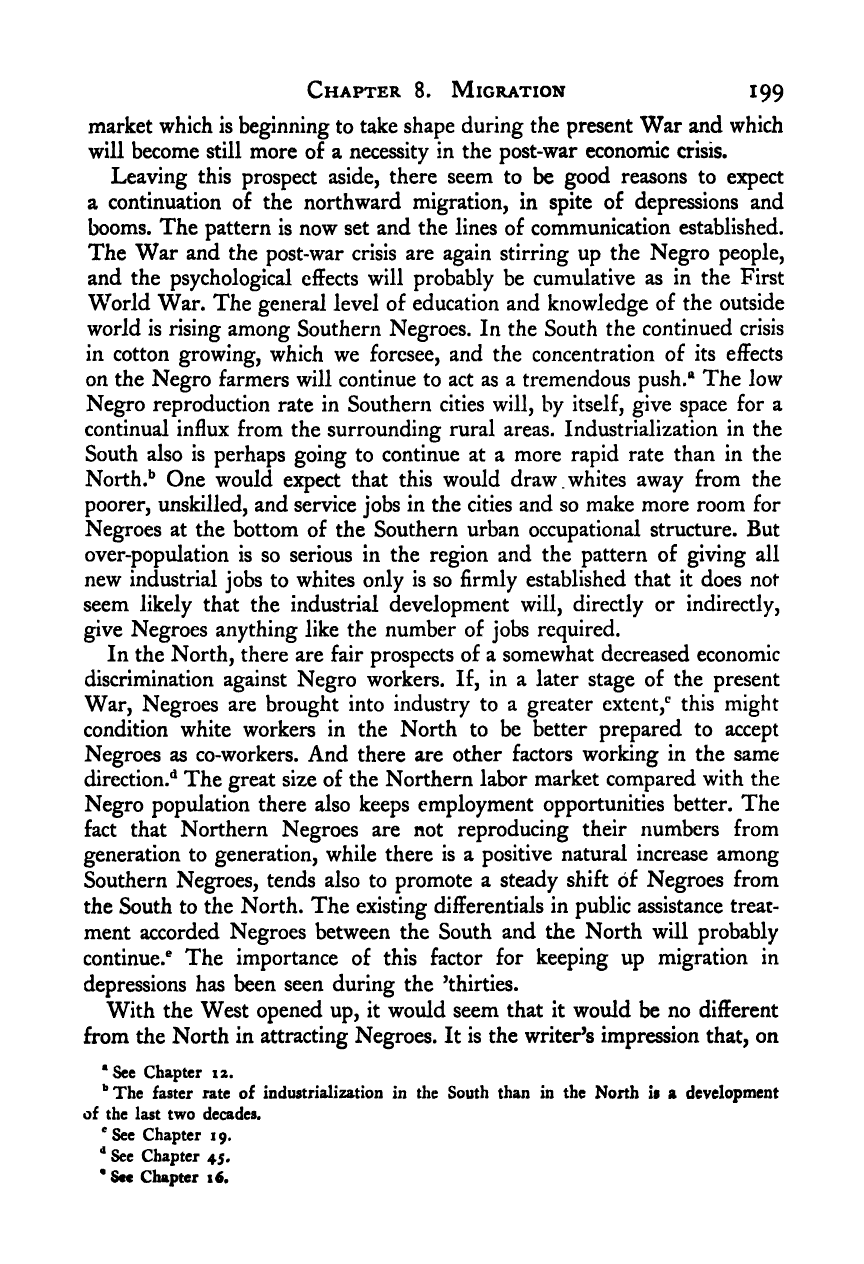Note: Gunnar Myrdal died in 1987, less than 70 years ago. Therefore, this work is protected by copyright, restricting your legal rights to reproduce it. However, you are welcome to view it on screen, as you do now. Read more about copyright.
Full resolution (TIFF) - On this page / på denna sida - III. Population and Migration - 8. Migration - 5. The Future of Negro Migration

<< prev. page << föreg. sida << >> nästa sida >> next page >>
Below is the raw OCR text
from the above scanned image.
Do you see an error? Proofread the page now!
Här nedan syns maskintolkade texten från faksimilbilden ovan.
Ser du något fel? Korrekturläs sidan nu!
This page has never been proofread. / Denna sida har aldrig korrekturlästs.
Chapter 8. Migration 199
market which is beginning to take shape during the present War and which
will become still more of a necessity in the post-war economic crisis.
Leaving this prospect aside, there seem to be good reasons to expect
a continuation of the northward migration, in spite of depressions and
booms. The pattern is now set and the lines of communication established.
The War and the post-war crisis are again stirring up the Negro people,
and the psychological effects will probably be cumulative as in the First
World War. The general level of education and knowledge of the outside
world is rising among Southern Negroes. In the South the continued crisis
in cotton growing, which we foresee, and the concentration of its effects
on the Negro farmers will continue to act as a tremendous push." The low
Negro reproduction rate in Southern cities will, by itself, give space for a
continual influx from the surrounding rural areas. Industrialization in the
South also is perhaps going to continue at a more rapid rate than in the
North.** One would expect that this would draw ,
whites away from the
poorer, unskilled, and service jobs in the cities and so make more room for
Negroes at the bottom of the Southern urban occupational structure. But
over-population is so serious in the region and the pattern of giving all
new industrial jobs to whites only is so firmly established that it does not
seem likely that the industrial development will, directly or indirectly,
give Negroes anything like the number of jobs required.
In the North, there are fair prospects of a somewhat decreased economic
discrimination against Negro workers. If, in a later stage of the present
War, Negroes are brought into industry to a greater extent,*^ this might
condition white workers in the North to be better prepared to accept
Negroes as co-workers. And there are other factors working in the same
direction.** The great size of the Northern labor market compared with the
Negro population there also keeps employment opportunities better. The
fact that Northern Negroes are not reproducing their numbers from
generation to generation, while there is a positive natural increase among
Southern Negroes, tends also to promote a steady shift of Negroes from
the South to the North. The existing differentials in public assistance treat-
ment accorded Negroes between the South and the North will probably
continue.® The importance of this factor for keeping up migration in
depressions has been seen during the ^thirties.
With the West opened up, it would seem that it would be no different
from the North in attracting Negroes. It is the writer’s impression that, on
‘See Chapter 12.
*’The faster rate of industrialization in the South than in the North is a development
of the last two decades.
* See Chapter 1 9.
" See Chapter 45,
* Sec Chapter 16*
<< prev. page << föreg. sida << >> nästa sida >> next page >>